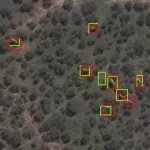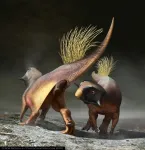(Press-News.org) Anyone who has tried and failed to meditate knows that our minds are rarely still. But where do they roam? New research led by UC Berkeley has come up with a way to track the flow of our internal thought processes and signal whether our minds are focused, fixated or wandering.
Using an electroencephalogram (EEG) to measure brain activity while people performed mundane attention tasks, researchers identified brain signals that reveal when the mind is not focused on the task at hand or aimlessly wandering, especially after concentrating on an assignment.
Specifically, increased alpha brain waves were detected in the prefrontal cortex of more than two dozen study participants when their thoughts jumped from one topic to another, providing an electrophysiological signature for unconstrained, spontaneous thought. Alpha waves are slow brain rhythms whose frequency ranges from 9 to 14 cycles per second.
Meanwhile, weaker brain signals known as P3 were observed in the parietal cortex, further offering a neural marker for when people are not paying attention to the task at hand.
"For the first time, we have neurophysiological evidence that distinguishes different patterns of internal thought, allowing us to understand the varieties of thought central to human cognition and to compare between healthy and disordered thinking," said study senior author Robert Knight, a UC Berkeley professor of psychology and neuroscience.
The findings, published this week in the Proceedings of the National Academy of Sciences journal, suggest that tuning out our external environment and allowing our internal thoughts to move freely and creatively are a necessary function of the brain and can promote relaxation and exploration.
Moreover, EEG markers of how our thoughts flow when our brains are at rest can help researchers and clinicians detect certain patterns of thinking, even before patients are aware of where their minds are wandering.
"This could help detect thought patterns linked to a spectrum of psychiatric and attention disorders and may help diagnose them," said study lead author Julia Kam, an assistant professor of psychology at the University of Calgary. She launched the study as a postdoctoral researcher in Knight's cognitive neuroscience lab at UC Berkeley.
Another co-author on the paper is Zachary Irving, an assistant professor of philosophy at the University of Virginia who explored the psychological and philosophical underpinnings of mind-wandering as a postdoctoral scholar at UC Berkeley.
"If you focus all the time on your goals, you can miss important information. And so, having a free-association thought process that randomly generates memories and imaginative experiences can lead you to new ideas and insights," said Irving, whose philosophical theory of mind-wandering shaped the study's methodology.
Irving worked with Alison Gopnik, a UC Berkeley developmental psychologist and philosophy scholar who is also a co-author of the study.
"Babies and young children's minds seem to wander constantly, and so we wondered what functions that might serve," Gopnik said. "Our paper suggests mind-wandering is as much a positive feature of cognition as a quirk and explains something we all experience."
To prepare for the study, 39 adults were taught the difference between four different categories of thinking: task-related, freely moving, deliberately constrained and automatically constrained.
Next, while wearing electrodes on their heads that measured their brain activity, they sat at a computer screen and tapped left or right arrow keys to correspond with left and right arrows appearing in random sequences on the screen.
When they finished a sequence, they were asked to rate on a scale of one to seven -- whether their thoughts during the task had been related to the task, freely moving, deliberately constrained or automatically constrained.
One example of thoughts unrelated to the task and freely moving would be if a student, instead of studying for an upcoming exam, found herself thinking about whether she had received a good grade on an assignment, then realized she had not yet prepared dinner, and then wondered if she should exercise more, and ended up reminiscing about her last vacation, Kam said.
The responses to the questions about thought processes were then divided into the four groups and matched against the recorded brain activity.
When study participants reported having thoughts that moved freely from topic to topic, they showed increased alpha wave activity in the brain's frontal cortex, a pattern linked to the generation of creative ideas. Researchers also found evidence of lesser P3 brain signals during off-task thoughts.
"The ability to detect our thought patterns through brain activity is an important step toward generating potential strategies for regulating how our thoughts unfold over time, a strategy useful for healthy and disordered minds alike," Kam said.
INFORMATION:
In addition to Kam, Knight, Irving and Gopnik, co-authors of the study are Shawn Patel at UC Berkeley and Caitlin Mills at the University of Hampshire.
For the first time, scientists have successfully used satellite cameras coupled with deep learning to count animals in complex geographical landscapes, taking conservationists an important step forward in monitoring populations of endangered species.
For this research, the satellite Worldview 3 used high-resolution imagery to capture African elephants moving through forests and grasslands. The automated system detected animals with the same accuracy as humans are able to achieve.
The algorithm that enabled the detection process was created by Dr Olga Isupova, a computer scientist at the University of Bath in the UK. The project was a collaboration with the UK's University of Oxford and the University of Twente in the Netherlands.
Dr ...
People's fear of 5G technology is rational. Such technology does emit radiation, even if it's at low levels. But 5G isn't all that different from 4G, and it certainly doesn't cause COVID-19 despite such rumors having spread rapidly across the globe.
Researchers need to better understand how misinformation like this spreads in order to hone their intervention efforts and prevent misinformed perspectives from taking root. In society's virtual world, preventing technological misinformation, in particular, is important now more than ever.
A research team led by Elaine Nsoesie, a Hariri Institute Faculty Fellow, investigated how COVID-19 misinformation proliferated using ...
A new study out of the University of Chicago and Stanford University on pairs of twins with and without food allergies has identified potential microbial players in this condition. The results were published on Jan. 19 in the Journal of Clinical Investigation.
The study grew out of prior research in the Nagler laboratory at UChicago on the fecal microbiota in infants. By transplanting fecal microbes from healthy and food-allergic infants to germ-free mice (who do not possess a microbiome), investigators found that the healthy infant microbiota was protective against the development ...
The synthetic chemicals known as PFAS, short for perfluoroalkyl and polyfluoroalkyl substances, are found in soil and groundwater where they have accumulated, posing risks to human health ranging from respiratory problems to cancer.
New research from the University of Houston and Oregon State University published in Environmental Science and Technology Letters suggests why these "forever chemicals" - so called because they can persist in the environment for decades - are so difficult to permanently remove and offers new avenues for better remediation practices.
The work focused on the interactions sparked when firefighters use ...
The abnormal immune system response that causes multiple sclerosis (MS) by attacking and damaging the central nervous system can be triggered by the lack of a specific fatty acid in fat tissue, according to a new Yale study. The finding suggests that dietary change might help treat some people with the autoimmune disease.
The study was published Jan. 19 in The Journal of Clinical Investigation.
Fat tissue in patients diagnosed with MS lack normal levels of oleic acid, a monounsaturated fatty acid found at high levels in, for instance, cooking oils, meats (beef, chicken, and pork), cheese, nuts, sunflower seeds, eggs, pasta, ...
With a name like glucose-6-phosphate dehydrogenase deficiency, one would think it is a rare and obscure medical condition, but that's far from the truth. Roughly 400 million people worldwide live with potential of blood disorders due to the enzyme deficiency. While some people are asymptomatic, others suffer from jaundice, ruptured red blood cells and, in the worst cases, kidney failure.
Now, a team led by researchers at the Department of Energy's SLAC National Accelerator Laboratory have uncovered the elusive mechanism behind the most severe cases of the ...
WASHINGTON, January 19, 2021 -- What causes brain concussions? Is it direct translational or rotational impact? This is one of the research areas currently being explored by Qianhong Wu's lab at Villanova University.
Our brains consist of soft matter bathed in watery cerebrospinal fluid (CSF) inside a hard skull. An impact on the hard skull is transmitted through the thin layer of CSF within the subarachnoid space to the soft brain matter.
In Physics of Fluids, from AIP Publishing, Wu and co-authors Ji Lang and Rungun Nathan describe studying another system with the same features, an egg, to search for answers. An egg resembles the brain, because its soft yolk is bathed within a liquid egg white inside a hard shell.
Considering that in most concussive brain injuries, the skull does ...
For the first time ever, a team of scientists, led by the University of Bristol, have described in detail a dinosaur's cloacal or vent - the all-purpose opening used for defecation, urination and breeding.
Although most mammals may have different openings for these functions, most vertebrate animals possess a cloaca.
Although we know now much about dinosaurs and their appearance as feathered, scaly and horned creatures and even which colours they sported, we have not known anything about how the vent appears.
Dr Jakob Vinther from the University of Bristol's School of Earth Sciences, along with colleagues Robert Nicholls, a palaeoartist, and Dr Diane Kelly, ...
With a small snout, a short and curled tail, and a big, round stomach, mini pigs are the epitome of cute--and sometimes, they snore. Now, researchers think these snoring pigs can be used to study obstructive sleep apnea. A study appearing January 19 in the journal Heliyon found that obese Yucatan mini pigs do have naturally occurring sleep apnea and that MRI scans taken while they're in sedated sleep can be used to gain new insights into what happens in the airways during sleep apnea episodes via computational flow dynamic (CFD) analysis.
"These are very fat pigs," says first author Zi-Jun Liu, a research professor and principal investigator in the Department of Orthodontics ...
WASHINGTON, January 19, 2021 -- Biomedical engineers developed a technique to observe wound healing in real time, discovering a central role for cells known as fibroblasts. The work, reported in APL Bioengineering, by AIP Publishing, is the first demonstration of a wound closure model within human vascularized tissue in a petri dish.
Prior investigations of wound healing have used animal models, but healing in humans does not occur the same way. One difference is that wounds in mice and rats, for example, can heal without granulation tissue, a type of tissue critical to the healing of human wounds.
Granulation tissue forms after blood coagulates, and the wound scabs over. Coagulation creates a fibrin network that serves as a temporary matrix. Granulation tissue then takes over, ...



